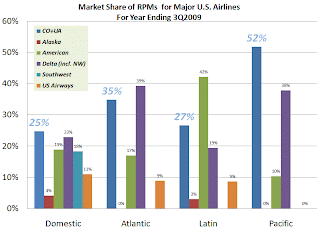I am revisiting the United and Continental merger analysis to provide an additional assessment of the market strengths of the merger potential. The first chart illustrates the market share for U.S. airlines by operating division. Note that this analysis is only for the seven largest U.S. airlines and I have added together CO and UA. The data is for the year ending with the 3Qtr 2009 and is taken from the airline's D.o.T. filings.
The United and Continental market shares are highlighted to demonstrate their market clout by operating region. As such, CO+UA had a 25% share of domestic passenger traffic (again this is for just seven airlines and doesn't include JetBlue, AirTran, Frontier, Spirit, regional airlines, etc, so that share is lower than indicated here); 35% of the Atlantic region, 27% of the Latin American region, and 52% of the Pacific region. The shares for the international sectors do not include foreign carriers. Of note, Delta (including NW) also has significant share standing with 23% domestic, 39% Atlantic (the highest share in that region), 27% for Latin America, and 38% for the Pacific. The other so-called Legacy carriers--American and US Airways--have significantly lower shares particularly on the international traffic sectors which may, over the long term, cause competitive disadvantages for AA and US. Indeed, in the Pacific region, Delta and UA+CO captured 90% of passenger traffic.
The second chart is really the 'money shot'. (Before I get into it, I should mention for those that don't know me that I have a reputation for creating 'busy' charts, i.e., charts with lots of data and words on them. The second chart is in that category; but stick with it as it is quite meaningful and in the end will be easy to understand, except maybe for those of you in Colorado....just kidding).
Anyway, the chart indicates growth RPKs (revenue passenger kilometers) on the horizontal axis for the 20-year period between 2008 and 2028 for major passenger traffic flows as taken from Boeing's 2009 Current Market Outlook. The market share for the CO+UA share of passenger traffic for the year ended 3Q2009 is on the vertical axis. The size of the circle represents the relative size of the growth RPKs for each of the major regions. The RPKs are for traffic flows in both directions, i.e., North America to/from Asia, etc. Note, North America is used as a proxy for the US as Boeing does not break-out US data independently (does Canada matter?).
From the Boeing data, I analyzed the traffic growth flows for the major regions for North American traffic. Thus, traffic forecasts are given for North America to/from Europe, intra North America, North America to/from Asia (including China), and North America to/from South and Central America. Those regions are placed on the chart with the center of each circle being the intersection of CO+UA's current market share with the size of forecast growth. To give you a sense of proportion, intra-North America traffic (according to Boeing) totaled 976 billion RPKs in 2008 and will grow to 1.6 trillion RPKs in 2028, an increase of about 600 billion RPKs (the size of the circle on the chart). This growth amounts to about 38% over 20 years which averages to just under 2% growth per year. Note that all airlines who can deploy capacity in these areas will be vying for a share of the market RPKs for the respective regions as indicated on the graph.
So how is the CO+UA merger positioned in each of these growth areas? As shown in the first chart, their shares in these important regions is quite competitive or even better. And in the context of the second chart, their current market share position bodes well for the capture of the growth RPKs over the long term. Their weakest market share is in the North America to/from South/Central America region. But those traffic flows have the lowest growth prospects of any of the traffic totals indicated on the chart.
From this analysis, it is clear that more consolidation in the U.S. will be inevitable. Both the Delta Northwest merger and now the Continental United merger raises the strategic stakes. Others, particularly American and US Airways, in their current forms, will be considerably weaker when they compete for future market shares in the growth markets against the merged entities.
Thursday, May 13, 2010
Subscribe to:
Post Comments (Atom)



No comments:
Post a Comment